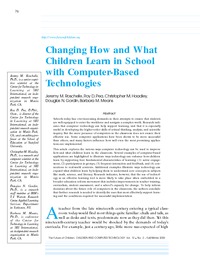Changing How and What Children Learn in School with Computer-Based Technologies Publikationsdatum:
Zu finden in: Children and Computer Technology, 2000
 |
 |
 Diese Seite wurde seit 10 Jahren inhaltlich nicht mehr aktualisiert.
Unter Umständen ist sie nicht mehr aktuell.
Diese Seite wurde seit 10 Jahren inhaltlich nicht mehr aktualisiert.
Unter Umständen ist sie nicht mehr aktuell.
 Zusammenfassungen
Zusammenfassungen
A description of computer technology applications that can improve how and what children learn in school, and the structural and organizational changes needed to help ensure computers are used effectively.
Von Klappentext im Text Changing How and What Children Learn in School with Computer-Based Technologies (2000) 
 Schools today face ever-increasing demands in their attempts to ensure that students are well equipped to enter the workforce and navigate a complex world. Research indicates that computer technology can help support learning, and that it is especially useful in developing the higher-order skills of critical thinking, analysis, and scientific inquiry. But the mere presence of computers in the classroom does not ensure their effective use. Some computer applications have been shown to be more successful than others, and many factors influence how well even the most promising applications are implemented. This article explores the various ways computer technology can be used to improve how and what children learn in the classroom. Several examples of computer-based applications are highlighted to illustrate ways technology can enhance how children learn by supporting four fundamental characteristics of learning:
Schools today face ever-increasing demands in their attempts to ensure that students are well equipped to enter the workforce and navigate a complex world. Research indicates that computer technology can help support learning, and that it is especially useful in developing the higher-order skills of critical thinking, analysis, and scientific inquiry. But the mere presence of computers in the classroom does not ensure their effective use. Some computer applications have been shown to be more successful than others, and many factors influence how well even the most promising applications are implemented. This article explores the various ways computer technology can be used to improve how and what children learn in the classroom. Several examples of computer-based applications are highlighted to illustrate ways technology can enhance how children learn by supporting four fundamental characteristics of learning: - active engagement,
- participation in groups
- frequent interaction and feedback, and
- connections to real-world contexts.
 in der Zeitschrift Children and Computer Technology im Text Changing How and What Children Learn in School with Computer-Based Technologies (2000)
in der Zeitschrift Children and Computer Technology im Text Changing How and What Children Learn in School with Computer-Based Technologies (2000)  Bemerkungen
Bemerkungen
 Leider ist die ursprünglich im Biblionetz erfasste URL eines Volltextes seit mehr als sechs Monaten nicht mehr gültig (Fehlermeldung 404) und wurde deshalb gelöscht. Es ist mir nicht bekannt, ob das Dokument unter einer anderen Adresse noch frei auf dem Internet verfügbar ist.
Leider ist die ursprünglich im Biblionetz erfasste URL eines Volltextes seit mehr als sechs Monaten nicht mehr gültig (Fehlermeldung 404) und wurde deshalb gelöscht. Es ist mir nicht bekannt, ob das Dokument unter einer anderen Adresse noch frei auf dem Internet verfügbar ist. Dieser Zeitschriftenartikel erwähnt ...
Dieser Zeitschriftenartikel erwähnt ...
 Dieser Zeitschriftenartikel erwähnt vermutlich nicht ...
Dieser Zeitschriftenartikel erwähnt vermutlich nicht ... 
 Nicht erwähnte Begriffe | Schule |
 Zitate aus diesem Zeitschriftenartikel
Zitate aus diesem Zeitschriftenartikel

 One of the biggest barriers to introducing effective technology applications in classrooms is the mismatch between the content of assessments and the kinds of higher-order learning supported most effectively by technology.
One of the biggest barriers to introducing effective technology applications in classrooms is the mismatch between the content of assessments and the kinds of higher-order learning supported most effectively by technology. in der Zeitschrift Children and Computer Technology im Text Changing How and What Children Learn in School with Computer-Based Technologies (2000)
in der Zeitschrift Children and Computer Technology im Text Changing How and What Children Learn in School with Computer-Based Technologies (2000)  Zitationsgraph
Zitationsgraph
 Zitationsgraph (Beta-Test mit vis.js)
Zitationsgraph (Beta-Test mit vis.js)
 2 Erwähnungen
2 Erwähnungen 
- Physical Programming - Designing Tools for Children to Create Physical Interactive Environments (Jaime Montemayor, Allison Druin, Allison Farber, Sante Simms, Wayne Churaman, Allison D’Amour) (2002)


- Implementation and Effects Of One-to-One Computing Initiatives - A Research Synthesis (William R. Penuel) (2006)


 Volltext dieses Dokuments
Volltext dieses Dokuments
 | Changing How and What Children Learn in School with Computer-Based Technologies: Artikel als Volltext ( : :  , 140 kByte) , 140 kByte) |
 Anderswo suchen
Anderswo suchen 
 Beat und dieser Zeitschriftenartikel
Beat und dieser Zeitschriftenartikel
Beat war Co-Leiter des ICT-Kompetenzzentrums TOP während er Dieser Zeitschriftenartikel ins Biblionetz aufgenommen hat. Die bisher letzte Bearbeitung erfolgte während seiner Zeit am Institut für Medien und Schule. Beat besitzt kein physisches, aber ein digitales Exemplar. (das er aber aus Urheberrechtsgründen nicht einfach weitergeben darf). Es gibt bisher nur wenige Objekte im Biblionetz, die dieses Werk zitieren.










 Computer
Computer Feedback (Rückmeldung)
Feedback (Rückmeldung) Gruppenarbeit
Gruppenarbeit Lernen
Lernen Motivation
Motivation



 Biblionetz-History
Biblionetz-History